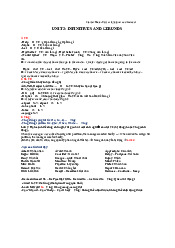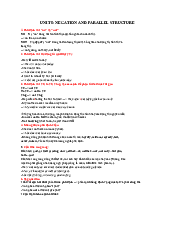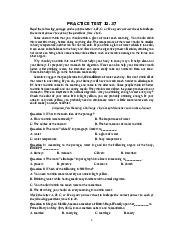

Preview text:
PRACTICE TEST 4
Name:...................................................................... Class:..........................................................
I. Reading comprehension (3 points) Job Sharing
Job sharing refers to a situation in which two people divide the responsibility of one full-time job. The two
people willingly act as part-time workers, working enough hours between them to fulfill the duties of a full-
time worker. If they each work half of the job, for example, they each receive 50 % percent of the job’s wages,
its holidays and its other benefits. Of course, some job sharers take a smaller or larger share of the
responsibilities of the position, receiving a lesser or greater share of the benefits.
Job sharing differs from obligatory part-time work in that it is mainly occurring in the more highly skilled
and professional areas, which involve higher levels of responsibility and employee commitment. Until recently,
these characteristics were not generally seen as compatible with full-time employment. Thus, the demands of
job sharing are needed by better pay and conditions and, ideally, more satisfaction than obligatory part-time work.
The types of jobs that are shared vary, but include positions that involve responsibility for many
subordinates. Research into shared senior management positions suggests that even such high-pressure work
can be shared between two people with little adjustment, if the personalities and temperaments of the sharers
are not vastly different from one another.
The necessity of close cooperation and collaboration when sharing a job with another person makes the
actual work quite different from obligatory one-position, one-person jobs. However, to ensure a greater chance
that the partnership will succeed, each person needs to know the strengths, weaknesses and performances of his
or her partner before applying for a position. More ever, there must be an equitable allocation of both routine
tasks and interesting ones. In sum, for a position to be job-shared well, the two individuals must be well-
matched and must treat each other as equals.
Comprehension questions:
1. Which heading can you give for the first paragraph?
2. List the differences between job sharing and obligatory part-time work.
3. What are the common job sharing areas?
4. What makes the job sharing different from obligatory one-position, one-person jobs?
5. What do the partners have to do for the successful job sharing?
6. What is the main aim of the writer of this article?
a. To encourage employers to allow more job sharing
b. To introduce the reader to the concept of job sharing
c. To advise people who wish to try job sharing
d. To discuss the implications of job sharing for industry
II. Choose the correct form of the word to fill each blank (2 points) unemployment vocational treated resources modernization sterilization professional defined migration state-sector multi-sector industrialization 1. The present Government’s policy is to
encourage ..................................from densely to thinly-
populated areas through the programmers such as the “building of new economic zones”.
2. Many scientists say that we must limit population growth because our ..............................are limited.
3. Some people are afraid of ..................................because if one of their children dies they won’t be able to have another.
4. It is forbidden to sign on children of less than 15 years of age except for some professions and jobs to
be ..................................by MOLISA.
5. Leaders of all countries in the world are confronting a serious problem-.....................................
6. The ....................................training should be introduced in the high school curriculum.
7. During the period of reconstruction, the largest channel for job creation is the development of
the ..................................economy.
8. State sector and the results of the ...........................................process will be the main sources of future
employment opportunities for the people of Viet nam.
III- Give the corresponding verbs for theses nouns (1point)
Employment necessity ability dismissal fall dependence reduction adoption promotion mobility
IV. Complete the sentences with the correct form of the word given in italics (2 points)
1. Occupational disease is a disease caused by the ................................effects of the labor conditions on the laborer. (harm)
2. Working conditions .............................in many productive branches are far from satisfactory. (practice) 3.
Some kinds of personal ...........................equipment are still lacking and are of low quality. (protection) 4.
Nowadays, there has been a trend of ...................................migration from rural to urban areas. (increase)
5. To solve .............................distribution of the population, Vietnamese government has encouraged many
families to move to new economic zones. (even)
6. Foreign enterprises may .............................. labor through the local office or by headhunting firm to do a
search. (recruitment)
7. The government allows private sales and distribution of family .................................. method. (plan) 8.
In our country the average area of land under ...................................is very low. (cultivate)
V. Translation (2 points)
The basic economic problem for any community is how to make the best use of its labour and other
resources. In economic terms, labour and other resources are called means of production or factors of production.
The volume of output is limited by the amount of factors of production. The more factors of production we have,
the more we can produce. The problem for any community is how to use its factors of production to the best
advantage. Therefore, the economic problem is how to allocate factors among different industries in order to
produce what the community wants most. In a given period we cannot have as much of everything as we want
because factors of production are limited in amount, but at least we can try to produce the particular assortment of
goods and services which the community prefers. .




